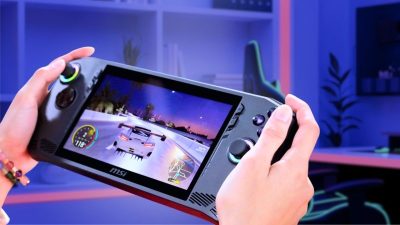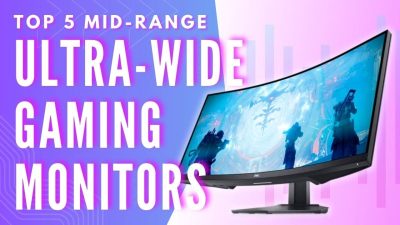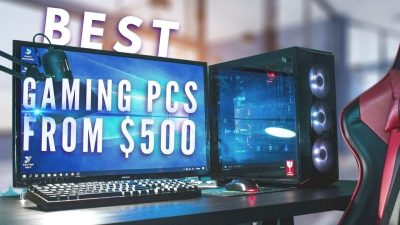📢 Disclosure: Some links on this page are affiliate links. As an Amazon Associate, I earn from qualifying purchases at no extra cost to you. Thanks for your support.

The MSI Claw, released in early 2024, has already seen an upgraded version released in early 2025. Now referred to as the “original MSI Claw”, it remains a relatively new handheld gaming device, yet it faces stiff competition in today’s market.
With the MSI Claw 8 AI+ now offering a larger screen, updated internals, and better efficiency, many are wondering if the original Claw is still a viable option or if it’s already outdated. Let’s break down its performance, features, and shortcomings to find out.
A rush to market?
The MSI Claw entered the market as a portable PC gaming device, designed to compete with industry leaders like the ROG Ally and Steam Deck. However, despite its solid hardware and ergonomic design, many have questioned whether MSI rushed its initial release.
One of the key concerns is the Intel chipset used in the Claw. Unlike most handhelds, which run on AMD processors, MSI opted for Intel, which could be seen as a bold but risky move. AMD and NVIDIA have dominated gaming processors for years, whereas Intel is still finding its footing in the handheld gaming sector.
Because of this, performance optimization has been inconsistent, with the Claw performing well in some games but falling behind in others. Some games run similarly to the Steam Deck, while others fall behind, with efficiency varying depending on the title and driver updates.
Would the MSI Claw have been better received if it had launched a year earlier? Possibly. Depending on the price, its performance may lag behind more optimized handheld options.
Ongoing improvements and the newer MSI Claw 8 AI+
To MSI’s credit, they have been actively improving game compatibility for the original Claw through software updates.
Their upgraded model, the MSI Claw 8 AI+, builds on that progress with a larger 8-inch display, improved controls, dual USB-C ports, and an Intel Lunar Lake processor for stronger graphics performance. With its 80 Wh battery, it’s designed for longer play sessions and a more refined overall experience.
The release of the 8 AI+ shows that MSI is responding directly to feedback from the first model. The new version aims to improve several weaknesses of the original, including:
- Larger 8-inch display
- Refreshed joystick and improved bumper buttons
- Dual USB-C ports
- Intel Lunar Lake processor with significantly upgraded GPU performance (as per manufacturer)
- 80 Wh battery for extended playtime
These upgrades suggest MSI is serious about making the Claw lineup competitive. But how does the original Claw hold up today?
Performance and key features of the original MSI claw
The original MSI Claw offers a comfortable Xbox-style design, a 7-inch 1080p 120Hz display, and solid cooling, though some users still report high temperatures in demanding games. Its Intel-based hardware delivers mixed performance depending on optimization, and battery life from the 53Wh pack usually lands a couple of hours. SSD speeds can vary by configuration, making file transfers slower for some users. Overall, it’s a well-designed handheld, and not bad value even if performance can be inconsistent at times
Ergonomics and comfort
One of the strongest aspects of the Claw is its ergonomic design. Modeled after the Xbox controller, the grip and button layout feel comfortable, even during long gaming sessions. In this area, MSI got things right, and it’s one of the device’s biggest selling points.
Display and resolution
The Claw comes with a 7-inch IPS touchscreen running at 1920×1080 resolution and a smooth 120 Hz refresh rate, which delivers fluid visuals and responsive controls, that can make the difference in fast-paced games.
While some handhelds trade off features for brighter or more vibrant displays, the Claw’s screen still offers a crisp, clear picture that works well for gaming and media on the go. For those wanting more screen real estate, the newer Claw 8 AI+ upgrades this to an 8-inch display which will be a welcome feature for players who prefer larger visuals.
Ventilation and overheating
The Claw features a well-ventilated design with rear cooling fans, but overheating can still occur in some graphically demanding games. While rare, some users report occasional instability during heavy gameplay.
Battery life
The 53Wh battery on the Claw should provide decent endurance, but because of Intel’s optimization challenges, its battery performance can vary. On higher settings, you can expect a couple of hours of playtime, which is similar to other handhelds like the Legion Go or ASUS ROG Ally, these devices all drain quickly under heavy load. Super saver mode can extend battery life on the Claw, though it does come with a noticeable drop in performance.
SSD performance
SSD performance can vary depending on the model and storage configuration. Some users have reported slower download and file-transfer speeds compared to devices like the Steam Deck or ROG Ally, which may be an issue for players who frequently install or move large game files.
Disclaimer: Product info, titles, and images may differ from descriptions due to updates. Always check the live listing for the most accurate information.
Specs breakdown: Original MSI claw vs. MSI Claw 8 AI+
| Feature | Original MSI Claw | MSI Claw 8 AI+ |
|---|---|---|
| Processor | Intel Core Ultra | Intel Lunar Lake |
| Graphics | Intel Arc Graphics | Upgraded GPU |
| Screen Size | 7-inch IPS (1080p, 120Hz) | 8-inch IPS (Improved Display) |
| RAM | 16GB | 32GB |
| Storage | 512GB – 1TB SSD | 1TB SSD |
| Battery | 53Wh | 80Wh (Longer battery life) |
| Ports | 1 USB-C | 2 USB-C |
| Cooling | Cooler Boost Tech | Improved Cooling |
Should you buy the original MSI Claw?
If you’re considering a handheld gaming PC today, the original MSI Claw does have its strengths, including:
- Comfortable ergonomic design
- Decent 7-inch display with 120Hz refresh rate
- Good grip and button placement
However, there are some key downsides, such as:
- Intel chipset struggles with optimization
- Battery life isn’t significantly better than competitors
- With graphically intensive games, reports of high temperatures or occasional instability can still happen and overheating remains a potential downside.
Should you get the MSI Claw 8 AI+?
If you already own the original MSI Claw, you may not want to upgrade immediately, but the 8 AI+ is still a meaningful improvement with its better performance, larger battery, and upgraded display. That being said, it does come at a higher price range. If you’re new to handheld gaming, there are several strong alternatives worth considering, including:
- Steam Deck – Best price-to-performance ratio (Read more about the Steam Deck here.)
- ROG Ally – More powerful processor and optimized gameplay (Learn more about the Asus Rog Ally.)
- Lenovo Legion Go – Bigger screen and strong hardware.
The MSI Claw 8 AI+, now launched, is a far stronger competitor than the original. The original MSI Claw remains usable and a good device, but it’s clearly overshadowed by the newer 8 AI+ model.
We hope this article helped you. Check out our other related articles on the links below.



